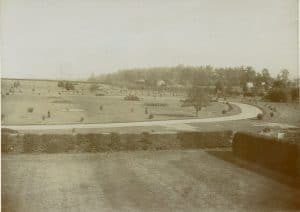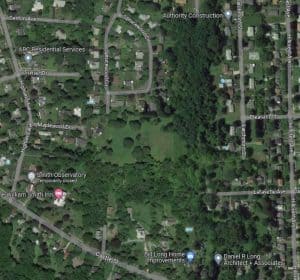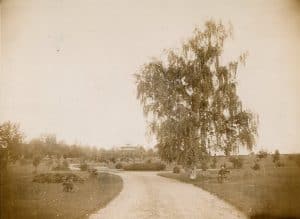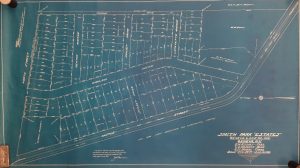The Interesting Life of Smith’s Park
By Becky Chapin, Archivist
There is very little information about Smith’s Park in our archives, so my first encounter with the name was a photograph of the park taken by Dr. William Brooks. The first mention of the park occurs in the Geneva Advertiser in May 1897. The park was on land owned by William Smith and was furnished by him from his nursery with trees, bushes, and flowers along with the construction of benches and winding roads.
The park is rarely mentioned in newspapers and subsequent Geneva history books. It’s unclear whether Smith’s Park was open to the public, but William Smith didn’t construct a fence around the area until 1906 so presumably it was. Nicknamed “Lover’s Lane,” the park was compared to Sonnenburg Gardens in Canandaigua which was under development by Mrs. Mary Clark Thompson.
The story of Smith’s Park also ties into the story of William Smith College. In 1903, the Geneva Advertiser-Gazette reported that William Smith College for Women was growing- “a big hole” had been dug “in the ground at what used to be known as ‘Smith’s Park’ consisting of twenty-six acres of beautiful land.”

Smith’s Park in its early stage. Photo taken from Smith Observatory (now Brooks Observatory) by Dr. Brooks.
Original plans for the college included constructing several buildings on William Smith’s land where the park currently existed. The Geneva Advertiser-Gazette reported “the plans are elaborate. Mr. Smith’s spiritualist advisors are here…” (for more on William Smith and spiritualism, visit The Smith Blog) but the editors didn’t think the venture would be successful “with no young women students to embrace spiritulism [sic].” William’s original goal for the college was to provide ample opportunity for psychic research and the study of obscure mental phenomena.
By 1904, the building of William Smith College was officially postponed because William had to direct his money to other projects. This left a big hole in the ground where the construction had begun which marred the landscape. By 1906, William Smith had made an agreement to set up his college under the Hobart College umbrella and plans to build it on Smith’s Park land were abandoned for good. In 1907, workers were sent in to remove the stone foundation and fill the hole back in.
The idea of a lakefront park was on the minds of city officials since 1900, but controversy surrounded the project right through to 1912 when newspapers started suggesting the possible purchase of Smith’s Park for a city public park. Given the city wanted to put the lakefront park right in the middle of factories and coal trains, many Genevans did not believe the lakefront was the right step, especially the editor of the Geneva Advertiser-Gazette, Edgar Parker who rallied against the construction of a park in the busy industrial lakefront.
After William Smith’s death in 1912, his nursery company W&T Smith purchased the land from William’s estate. Propositions to purchase Smith’s Park were put to the Common Council many times from 1913, but the price set by William’s nephew Theodore Smith of $25,000, including the Octagon house and adjoining two acres, was too expensive.
From 1913 to 1914, rumors spread that the park land was going to be cut up into building lots and sold, while the Common Council brought a proposal to city voters whether to purchase the park or not. The proposition was defeated in 1914 by 66 votes, 422 for and 488 against. Opinions seemed to be that taxpayers didn’t want to pay for maintenance of the park. The newspaper instead proposed an association be formed by wealthy citizens to purchase the park for the community to enjoy.
The park land sat empty until it was purchased by Rochester businessmen George Rogers and PH Ritchie in 1921 under the Geneva Land Co. They expressed their wish to keep some of the trees and shrubs but cut much of the land up into estates. This area would become Smith Park Estates and encompasses present day Highland Ave and Sunset Drive, which were created because of this project, and extended from Castle to North Street.

Looking at a map of the area today, this may explain why there is a large portion of undeveloped land between Castle and North Street.
During the construction of homes, many of the shrubs and a few trees were moved within the estate or from Smith’s Park to Pulteney and Lakeside Parks by the city Park Commission. Lots were quick to sell, with 51 out of 90 purchased within a month and could cost anywhere from $500 to $1500 depending on location. Many of the houses in this area were constructed by the same builders so if you live in that area, look around and see if you notice similarities with your neighbors’ homes.



Very interesting. I had never heard of Smith’s Park.
Becky, Another great piece on Geneva’s history. Thank you for the research on Smith Park and the upper Castle Street area.